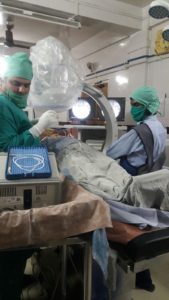
Trigeminal Neuralgia
Trigeminal Neuralgia
Back pain is pain felt in the back. Episodes of back pain may be acute, sub-acute, or chronic depending on the duration. The pain may be characterised as a dull ache, shooting or piercing pain, or a burning sensation. The pain may radiate into the arms and hands as well as the legs or feet, and may include paresthesia (tingling with no apparent cause), weakness or numbness in the legs and arms. The anatomic classification of back pain follows the segments of the spine: neck pain (cervical), middle back pain (thoracic), lower back pain (lumbar) or coccydynia (tailbone or sacral pain) with the lumbar vertebrae area most common for pain.
The pain may originate from the muscles, nerves, bones, joints or other structures in the vertebral column (spine). Internal structures such as the gallbladder and pancreas may also cause referred pain in the back.
Back pain is common with about nine out of ten adults experiencing it at some point in their life, and five out of ten working adults having it every year. However, it is rare for it to be permanently disabling, and in most cases of herniated disks and stenosis, rest, injections or surgery have similar general pain resolution outcomes on average after one year. In the United States, acute low back pain is the fifth most common reason for physician visits and causes 40% of missed days off work. Additionally, it is the single leading cause of disability worldwide.
Prevention
There is moderate quality evidence that suggests the combination of education and exercise may reduce an individual’s risk of developing an episode of low back pain.[26] Lesser quality evidence points to exercise alone as a possible deterrent to the risk of the onset of this condition.
Management
The management goals when treating back pain are to achieve maximal reduction in pain intensity as rapidly as possible, to restore the individual’s ability to function in everyday activities, to help the patient cope with residual pain, to assess for side-effects of therapy, and to facilitate the patient’s passage through the legal and socioeconomic impediments to recovery. For many, the goal is to keep the pain to a manageable level to progress with rehabilitation, which then can lead to long-term pain relief. Also, for some people the goal is to use non-surgical therapies to manage the pain and avoid major surgery, while for others surgery may be the quickest way to feel better.
Not all treatments work for all conditions or for all individuals with the same condition, and many find that they need to try several treatment options to determine what works best for them. The present stage of the condition (acute or chronic) is also a determining factor in the choice of treatment. Only a minority of back pain patients (most estimates are 1% – 10%) require surgery.

